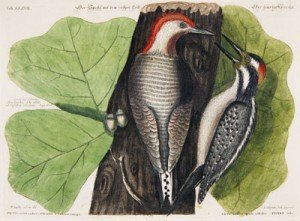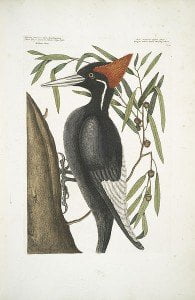Here’s a quick bit of fun for the trivially inclined.
What do Gray Catbird, Chuck-will’s-Widow, White-breasted Nuthatch, Rusty Blackbird and Red-bellied Woodpecker have in common?
At first glance not a lot, besides being birds of course, and more or less occurring across most of the eastern half of the United States (and in the case of the Nuthatch, much of the rest too). The common thread lies in their scientific name; for each species a similar etymology that has changed little in the nearly 300 years since they were first formally described. One that’s certainly recognizable once pointed out. Be it the Gray Catbird’s Dumetella carolinensis or the Rusty Blackbird’s Euphagus carolinus, they all reference this particular part of the southeast. But why? Why would the other great locales of natural history be left in the dust by this seemingly inauspicious corner of the continent? These carolinensii are so prolific that there’s scarcely another place name that shows up so regularly in Linnaeus’s records. And does it really matter what word is attached to a name no birder ever really uses?
 It’s perhaps not to surprising that despite their taxonomic difference, the reference to the Carolinas is not a coincidence. At the turn of the Century, that’s the 18th Century mind you, the continent of America was mostly an unknown quantity. European colonization had been centered in the Northeast ,and the Southeast corner was still, in many ways, unknown It’s hard to think of a region that has now devolved into sprawl and agriculture as a wilderness but it was. There were dense black swamps, pine barrens with 150 foot tall trees, a coastline of dunes and wind and little else. Even the protected areas we now consider to be “reclaimed” are nothing more than pale shadows of the southeast of 300 years ago. So it goes.
It’s perhaps not to surprising that despite their taxonomic difference, the reference to the Carolinas is not a coincidence. At the turn of the Century, that’s the 18th Century mind you, the continent of America was mostly an unknown quantity. European colonization had been centered in the Northeast ,and the Southeast corner was still, in many ways, unknown It’s hard to think of a region that has now devolved into sprawl and agriculture as a wilderness but it was. There were dense black swamps, pine barrens with 150 foot tall trees, a coastline of dunes and wind and little else. Even the protected areas we now consider to be “reclaimed” are nothing more than pale shadows of the southeast of 300 years ago. So it goes.
Into this frontier came all sorts of individuals, notably one Mark Catesby, an English born naturalist who emigrated to Virginia to live with his sister in 1712. Gentleman naturalists were all the rage back then, and Catesby no different. He was a botanist by reputation and made some money sending seeds and samples of native Virginia plants back to English horticulturalists and making a name for himself among scientists in the old country. He was eventually recommended to travel on a natural history expedition to the Carolinas in 1722 and soon found himself in Charleston, South Carolina, where he based himself for the next six years traveling across the region and beyond, even heading off to the West Indies collecting birds and plants and sending them back to collectors in England.
 When he returned to Europe himself he began his magnum opus, a two volume brute called The Natural History of Carolina, Florida, and the Bahama Islands: Containing the Figure of Birds, Beasts, Fishes, Serpents, Insects, and Plants, that he would mete out over the next sixteen years. His illustrations, while not on par with the naturalist-painters like Alexander Wilson and the great John James Audubon who would come half a century later, were notable for being the first to be published full folio sized and included wildlife posed with appropriate native plants, a novel approach and one perfected by Audubon. But what does all this have to do with the species name, carolinensis?
When he returned to Europe himself he began his magnum opus, a two volume brute called The Natural History of Carolina, Florida, and the Bahama Islands: Containing the Figure of Birds, Beasts, Fishes, Serpents, Insects, and Plants, that he would mete out over the next sixteen years. His illustrations, while not on par with the naturalist-painters like Alexander Wilson and the great John James Audubon who would come half a century later, were notable for being the first to be published full folio sized and included wildlife posed with appropriate native plants, a novel approach and one perfected by Audubon. But what does all this have to do with the species name, carolinensis?
The popularity of Catesby’s work was not lost on the great Carolus Linneaus, who included much of the information collected by Catesby in his seminal Systema Naturae. Since so many of the species in the book were first formally described from specimens taken by Catesby in Carolina, Linneaus tagged them for all time as carolinensis, and that’s how they’ve stayed. In fact, the species names was historically far more prevalent, applied as it was to birds like Mourning Dove, Dark-eyed Junco, Yellow-billed Cuckoo, and American Robin before they became macroura, hyemnalis, americanus and migratorius respectively. Carolina’s place in ornithological history is substantial, but it used to be even more so.
For his own work however, Linneaus deemed Catesby himself inconsequential enough to assign only one species to his name, the American Bullfrog, Rana catesbeiana.
You can’t win them all.





 New writers welcome – please contact us for details.
New writers welcome – please contact us for details.

















Great post!
And maybe Linneaus giving Catesby the frog was his way of saying that Catesby was a prince of a fellow? Yeah, probably not…
Oh, he flipped him the frog… That’s a new one.
Your (great!) post might inspire me to write something similar about “capensis” in African animal names. No wait, just listing the birds would require an entire extra server, so nevermind.
@Corey- Wait, so it’s not a great honor to have, pound for pound, North America’s most voracious predator named after you?
@Jochen- So you’re saying taxonomists in South Africa are lazy…
@Nate: yes. Must be the cricket, the sun, and gin tonic (or brandy & coke).
@Jochen- Crikey! Another Gerbera! Better make this one capensis too, I reckon…
@ Nate: Ha 🙂 Actually, South African taxonomists are (in)famous for splitting genera just so they can describe more species with the name “capensis”.
I’ve heard.
Why was the specific name of the robin, dove, etc. changed if Linneaus used carolinensis? Wouldn’t his name have priority?
@Derek- This was back when every self-styled naturalist was naming everything in sight. Mourning Dove, in particular, was given the name Turtur carolinensis, Turtle Dove, by Catesby, which was changed to Columba carolinensis by Linnaeus.
This, unfortunately, was after a bird called the Long-tailed Dove, Columba macroura, was described by a British surgeon named George Edwards, who illustrated the bird so poorly with such a ridiculously outsized tail that Linnaeus thought it was a different species. When it was discovered they were the same, macroura had priority.
As for the Junco, carolinensis lives on in a subspecies that Catesby called a full species, which was eventually lumped. In fact, if you include ssp, there are tons more carolinensii for that reason.
Cuckoo and Robin were birds named by Catesby that never caught on in the greater scientific community.
and of course, Carolina Wren is Thryothorus ludovicianus….
Nate, the sign of a good writer is to take a potentially boring topic and make it interesting and enjoyable to read. Let it be said I have enjoyed every one of your posts to date.
awesome!!!!!!!!!!!!!!!!!!!!!!!!!!!!!!!!!!!!!!!!!!!!!!!!!!!!!!!!!!!!!!!!!!!!!!!!!!!!!!!!!!!!!!!!!!!!!!!!!!!!!!!!!!!!!!!!!!!!!!!!!!!
Yes, excellent post. One of my New Year’s resolutions is to learn more scientific/latin bird names, so thanks! Did you know that you can buy the original 2 folio volumes for $550,000 from the W. Graham Arader III gallery in NYC?
(Or see it here: http://www.botanicus.org/title/b11924998)
about the “capensis” theme, why a bird not found in Africa is named Zonotrichia capensis? Mislabed specimens? Another meaning for the “capensis” part?
Thanks all!
@Jan Axel- That’s a good question. My guess would be that it refers to another cape, perhaps the one at the southern tip of South America? But I don’t know for sure.
Just happened to have my sparrow book next to the computer. The Rufous-collared Sparrow (Z. capensis) does range south to Cape Horn, so you’re probably right, Nate.
Great information, Nate, thank you.
Very few (possibly none) of the “Catesby” birds were named from specimens; the types are actually the paintings, one of the great bizarrenesses in the history of taxonomy.
@Rick- Thanks!
Too true. I probably should have made that clearer. I used to think that Catesby was sending actual specimens to Linnaeus, but realized I was wrong when I noticed the period they were doing most of their work didn’t overlap much at all.
I can’t imagine how difficult that must have been for Linnaeus, to have to get past the personal idiosyncrasies of so many illustrators to parse out different species.